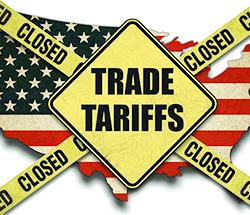26.06.2019 - Studies

According to the standard textbook view, a negative impact of “trade wars” on growth occurs mainly through lower trade volumes, higher domestic prices and thus lower consumption and investment. Looking at the US data, there is some evidence for these direct effects, but they are small. More serious is the collateral damage of the “trade war” on confidence.
Direct effects of the US-China trade war
Trade flows between the US and China have slowed significantly since the “trade war” began in early 2018. However, this had only a minor impact on overall US trade flows (exports and imports), which remained relatively stable over the same period (Fig. 1). Finally, the direct growth impact from the change in trade flows is negligible, as the contribution of net exports to GDP growth is relatively small.1
There is also some evidence suggesting that domestic prices on products affected by trade tariffs increased faster than on all other product categories (Fig. 2). However, the effect is not sizeable, reflecting the negligible cumulative weight of 2.4% that the tariff-impacted products have in the consumption basket underlying the consumer price index (CPI) in the US.2
Collateral effects of the US-China trade war
Besides the direct effects, the trade war impacts economic growth through indirect channels. Their precise measurement is difficult, as it often takes time for them to unfold. But the available evidence is already serious.
The indicators measuring the confidence of US businesses are sending worsening signals across the board. The Business Conditions Activity Index of the Federal Reserve Bank of Chicago, the Sentix Economic Expectations Index and the ifo index measuring the economic situation of the US economy in the next 6 months have weakened since March 2018 (Fig. 3). Moreover, given strong international trade dependences, negative spillovers have also reached businesses abroad in US and China trading partner countries.
Caution towards the future, which has been emerging for several quarters now, is already reflected in management decisions on a broad front. The Purchasing Managers Index for the manufacturing and service sector has been on a downward trend since mid-2018 (Fig. 4). US industrial production and new orders in capital goods have also fallen since the end of 2018 (Fig. 5).
Caution required
There is growing evidence that trade tensions are now having negative effects on the US economy. In view of the approaching presidential campaign in the US, it should be in president Trump’s interest to reach a “beautiful deal” on trade at the upcoming G20 summit.
However, uncertainties remain. First, other factors, such as new Iran sanctions and more general geopolitical tensions, are likely to add fuel to the fire and counter any relief on trade front. Second, a trade deal would have to signal lasting peace so as to achieve a reversal in economic expectations. Finally, it is unsure to which extent the Chinese government would eventually be willing to cooperate on a deal that would primarily serve to support Trump’s poll results. After all, trade wars may not be so easy to win as President Trump believes.
